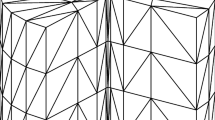Abstract
In this paper, metrics derived from a posteriori error estimates for the Poisson problem and for the Stokes system solved by some finite element methods are presented. Numerical examples of mesh adaptation in two dimensions of the space are given and show that these metrics detect the singular behavior of the solution, in particular its anisotropy.


Similar content being viewed by others
References
Alauzet F, Frey P (2005) Anisotropic mesh adaptation for CFD computations. Comput Methods Appl Mech Eng 194(48–49):5068–5082
Bernardi C, Girault V, Hecht F (2003) A posteriori analysis of a penalty method and application to the Stokes problem. Math Models Methods Appl Sci 13(11):1599–1628
Cao W (2007) An interpolation error estimates on anisotropic meshes in \(\mathcal{R}^n\) and optimal metrics for mesh refinement. SIAM J Numer Anal 45(6):2368–2391
Carstensen C, Funken SA (2001) Averaging technique for FE - a posteriori error control in elasticity.part ii: λ-independent estimates. Comput Methods Appl Mech Eng 190:4663–4675
Carstensen C, Verfürth R (1999) Edge residuals dominate a posteriori error estimates for low order finite element methods. SIAM J Numer Anal 36(5):1571–1587
Creusé E, Kunert G, Nicaise S (2004) A posteriori error estimation for the Stokes problem: Anisotropic and isotropic discretizations. Math Models Methods Appl Sci 14(9):1297–1341
Dolešjí V (1998) Anisotropic mesh adaptation for finite volume and finite element methods on triangular meshes. Comput Vis Sci 1:165–178
Formaggia L, Micheletti S, Perotto S (2004) Anisotropic mesh adaptation in computational fluid dynamics: application to the advection–diffusion–reaction and the stokes problems. Appl Numer Math 51(4):511–533. http://dx.doi.org/10.1016/j.apnum.2004.06.007
Girault V, Raviart P-A (1986) Finite Element methods for Navier–Stokes equations theory and algorithms, vol. 5. Springer Series in Computational Mathematics, Springer, New York
Hecht F (1998) The mesh adapting software: bamg. INRIA report. http://www-c.inria.fr/gamma/cdrom/www/bamg/eng.htm
Hecht F, Georges PL (1999) Nonisotropic grids. CRC, Boca Raton, FL
Hecht F, Kuate R (2008) Metric generation for a given error estimation. In: Proceedings of 17th international meshing roundtable. Springer, Berlin, pp 569–584
Hecht F, Pironneau O Freefem++, language for finite element method and PDEs., Laboratoire Jacques-Louis Lions, Université Pierre et Marie Curie, http://www.freefem.org/ff++/
Houston P, Süli E (2000) Adaptive Lagrange-Galerkin methods for unsteady convection-diffusion problems. Math Comput 70:77–106
Kröner D, Ohlberger M (1999) A posteriori error estimates for upwind finite volume schemes for nonlinear conservation laws in multi dimensions. Math Comput 69(229):25–39
Kunert G, Verfürth R (2000) Edge residuals dominate a posteriori error estimates for linear finite element methods on anisotropic triangular and tetrahedral meshes. Numerishe Mathematik 86:283–303
Picasso M (2003) An anisotropic error indicator based on Zienkiewicz-Zhu error estimator: application to elliptic and parabolic problems. SIAM J Sci Comput 24(4):1328–1355 (electronic)
Sonar T, Süli E (1998) A dual graph-norm refinement indicator for finite volume approximations of the Euler equations. Numerishe Mathematik 78:619–658
Verfürth R (1993) A posteriori error estimators and adaptative mesh-refinement techniques. J Comput Appl Math 50:67–83
Yan N, Zhou Z (2009) A priori and a posteriori error analysis of edge stabilization galerkin method for the optimal control problem governed by convection-dominated diffusion equation. J Comput Appl Math 223(1):198–217
Acknowledgments
This work was carried out in the EGSISTES project supported by the French National Research Agency, ANR, under contract ANR-06-SECU-004-02. The author also thanks Serge Nicaise for fruitful discussions.
Author information
Authors and Affiliations
Corresponding author
Rights and permissions
About this article
Cite this article
Kuate, R. Anisotropic metrics for finite element meshes using a posteriori error estimates: Poisson and Stokes equations. Engineering with Computers 29, 497–505 (2013). https://doi.org/10.1007/s00366-012-0276-8
Received:
Accepted:
Published:
Issue Date:
DOI: https://doi.org/10.1007/s00366-012-0276-8




